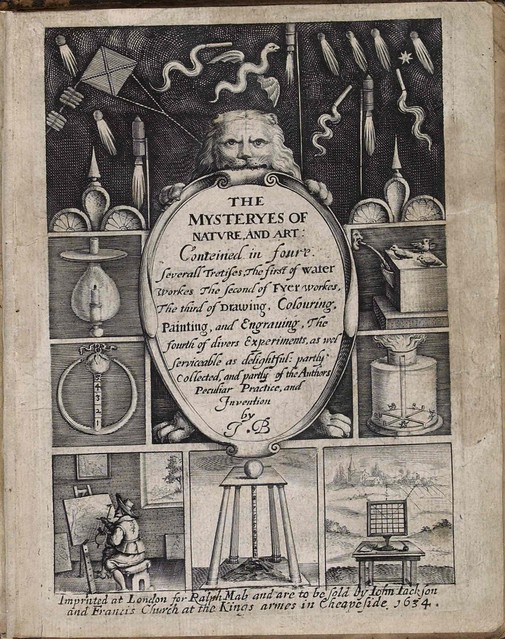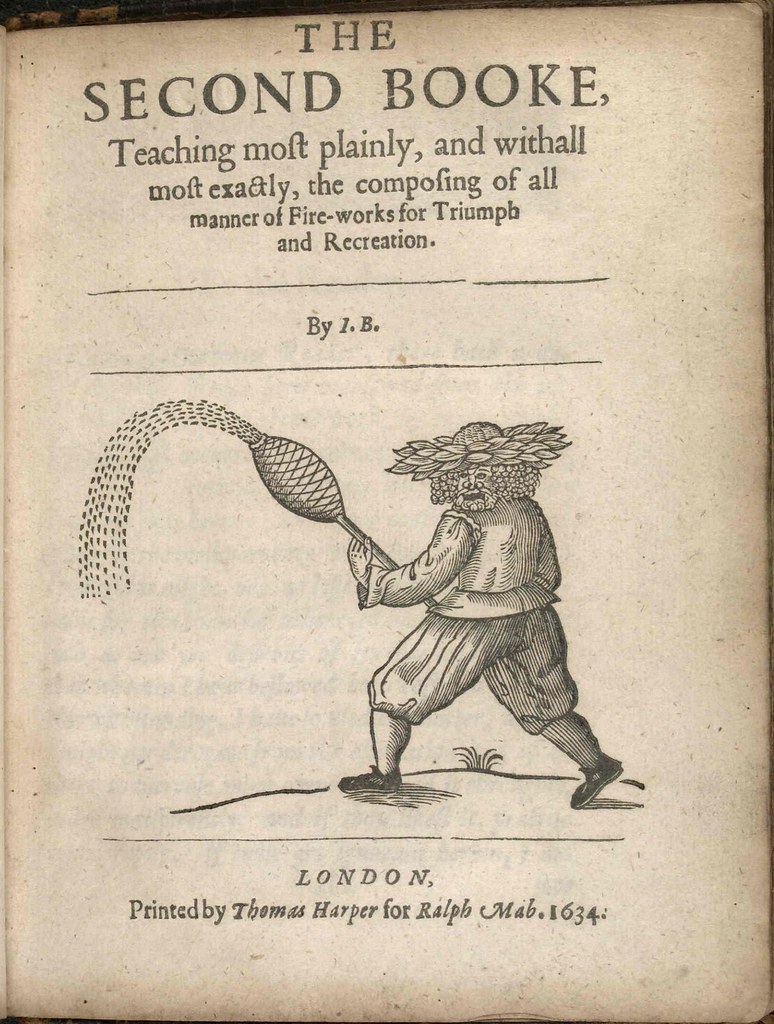


Another manner of forcing the water, whereby the water of any ſpring may be forced unto the top of a hill
Let there be two hollow poſts, with a ſuccur at the bottom of each, alſo a ſuccur nigh the top of each; let there be faſtened unto both theſe poſts a ſtrong peece of timber, having, as it were, a beame or ſcale pinned in it, and having tow handles, at each end one...

...whereat the water may be mounted into divers ceſterns, out of ſome wherof there may be made convayances in their bottoms, by ſmall pipes running down into the river or moat again, and there breaking out in the faſhions and formes of Dragons, Swans, Whales, Flowers, and ſuch like pretty conceits : out of others the water may fall upon wheeles, out of whoſe ſpindles, the water turning round, may bee made to run...

"The beginning of the section on fireworks boasts its own title-page. This is illustrated with a woodcut depicting a 'green man' wielding a fire club. With obscure and mythical origins, 'green men' dressed in foliage and garlands traditionally led processions of fireworkers from medieval times.
Their role was in part to maintain order; according to one scholar, 'strewing fire from large clubs, they cleared the way for certain festive processions. The "wild men", "very ugly to behold" are described as having black beards and black hair, with garlands on their heads, and wearing costumes of green ivy.' The customary greeting amongst the firework fraternity is still 'stay green'." [source | Also see this]












It's really not too difficult to report on John Bate, the author of this most intriguing 1634 book, 'The Mysteryes of Nature and Art', as next to nothing is known about him. At least he admits in the title and preface of his influential tome that he collected experiments and recipes from a variety of sources, so we might judge well of his character for being so truthful in an age when intellectual property theft was rampant in publishing.
His technology-come-artisan-come-folk alchemy manual combined perceptive observations with fanciful whimsy in just the right balance. The promise of practical hydraulics and the secret ingredients of fireworks and medical remedies - copiously illustrated with amazing woodcuts - struck a chord with the book-buying public. Within a few years an expanded 2nd edition - that included a portrait of the author - was released and met with similar success.
Isaac Newton was given a copy of 'The Mysteryes' as a teenager by the headmaster at his school. He is known to have copied out sections of the book assiduously and he built working models of a water clock and water wheels that Bate had described.
But it wasn't just an exciting book for nerds and aspiring pyromaniacs. The book contained one of the first mentions in Europe of a kite and was one of the first English books with a section devoted to building and arming fireworks.
"While some of the knowledge imparted in Bate's Mysteries may seem to us crude, if not downright eccentric, it is important to remember that manuals such as these did play an important role in the dissemination of scientific and technical information throughout the Renaissance."And, if it needs to be said, reading the language of the period is just wonderful: it's old enough to be entertainingly weird, but young enough that it's all fairly straight forward on the comprehension front.
- All the images from 'The Mysteryes of Nature and Art' that appear above were sourced from the Library of Congress copy (Rosenwald 1480). (I recommend downloading the 70Mb pdf)
- Glasgow University Book of Month in 2003.
- Hamish Riley-Smith Rare Books and Manuscripts.
- Engines of Our Ingenuity No. 2442.
- A reprint of the original book, billed as 'The Mysteries of Nature and Art' was released by EEBO in 2010.
- Previously: machines.
- Follow along at Twitter.
Tidak ada komentar:
Posting Komentar